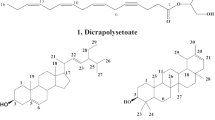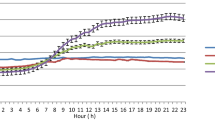Abstract
The antifungal agent 15-azasterol A25822B was examined for effects on the growth and development of Ascosphaera apis. The minimum inhibition concentration (MIC) of azasterol against A. apis was 1 μm. Growth and development of A. apis was completely controlled at this concentration. At a concentration of 0.01 μm growth of A. apis was retarded and although sporocysts were formed developing spores were not be able to reach maturation. A major effect of azasterol at this low concentration was the accumulation of lipid in the hyphae, sporocysts and immature spores. In addition it caused a conformational change in mitochondria and damage to the spore membrane structure. On the basis of these results, further investigations of azasterol for the treatment of chalkbrood disease in the honey bee are warranted.
Similar content being viewed by others
References
Baker GM, Torchio PF. New records for Ascosphaera apis from North America. Mycologia 1968; 60: 189–190.
Heath LAT. Occurrence and distribution of chalkbrood disease of honey bees. Bee World 1985; 66: 9–15.
Herbert EW Jr, Chitwood DJ, Shimanuki H. New compounds with potential for the control of chalkbrood. Am Bee J 1985; 125: 430–431.
Glinski Z, Rzedzichi J. Chalkbrood disease of the honey bee (Apis mellifica L.): the in vitro studies of some antimycotics with particular reference to polyene antibiotics. Polskie Archiwum Weterynaryjn 1980; 22: 315–21.
Georgopapadakou NH, Dix BA, Smith SA, Freudenberger J, Funke PT. Effect of antifungal agents on lipid biosynthesis and membrane integrity in Candida albicans. Antimicrob Agents Chemother 1987; 31: 46–51.
Michel KH, Hamill RL, Larsen SH, Williams RH. New azasteroidal antifungal antibiotics from Geotrichum flave-brunneum, II: isolation and characterization. J Antibiot 1975; 28: 102–111.
Bailey L. Honey bee pathology. London/New York: Academic Press, 1981.
Moor H, Mühlethaler K. Fine structure in frozen etched yeast cells. J Cell Biol 1963; 17: 609–628.
Hays PR, Parks LW, Pierce HD, Oehlschlager A.C.. Accumulation of ergosta-8,14-dien-3B-ol by Saccharomyces cerevisiae cultured with an azasterol antimycotic agent. Lipids. 1977; 12: 666–68.
Taylor FR, Rodriguez RJ, Parks LW. Relationship between antifungal activity and inhibition of sterol biosynthesis in miconazole, clotrimazole, and 15-azasterol. Antimicrob Agents Chemother 1983; 23: 515–512.
Woloshuk CP, Sisler HD, Dutky SR. Mode of action of the azasteroid antibiotic 15-aza-24-methylene-D-homocholesta-8,14-dien-3B-ol in Ustilago maydis. Antimicrob Agents Chemother 1979; 16: 81–86.
Vartapetian BB, Zakhmylora NA, Generozova IP. Ultrastructure of wheat coleoptile mitochondria at short-term anoxia and post-anoxia. Plant Cell and Environment 1985; 8: 65–67.
Evenson DP, Lee J, Darzynkiewicz A, Melamed MR. Rhodamine 123 alters the mitochondrial ultrastructure of cultured L1210 cells. J Histochem Cytochem 1985; 33: 353–59.
Author information
Authors and Affiliations
Additional information
Work was performed during sabbatical leave at the University of California, Davis.
Rights and permissions
About this article
Cite this article
Liu, T.P., Peng, C.Y.S., Mussen, E.C. et al. In vitro activity of 15-azasterol (A25822B) against chalkbrood pathogen Ascosphaera apis in the honey bee. Mycopathologia 115, 175–184 (1991). https://doi.org/10.1007/BF00462222
Received:
Accepted:
Issue Date:
DOI: https://doi.org/10.1007/BF00462222




